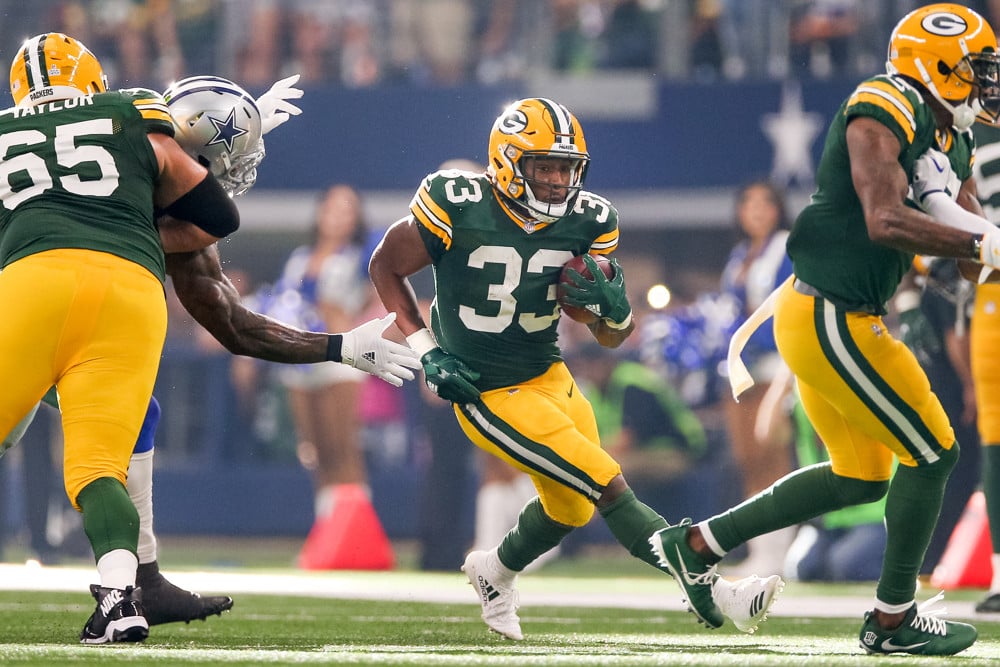Who will be the consensus first-round fantasy picks in 2020? If we knew the answer, we’d be rich. We’d simply draft as many of them as we could in our season-long leagues, bet the overs on all their props, trade for them in Dynasty and roster them every week in DFS until prices adjusted. Of course, we don’t.
But there are thoughtful ways to examine this question. Essentially we are looking for players who have realistic paths to hitting the top of their range this season. A median outcome from a player will not yield much profit on their current ADP. In other words, there’s not a wide distribution of outcomes on players we know a lot about already, such as Zach Ertz, Stefon Diggs or Sammy Watkins. For a lot of reasons, their range of outcomes is smaller.
Instead, we are looking for players with wide ranges and high ceilings. They are often young running backs and wide receivers because in this league, older veterans at those positions are almost certainly in decline. We’re looking for players with a few “if” statements attached, but when those statements all come true we have actual first-round upside.
On top of that, we need to be aware of what kind of players can ascend to this rarified first-round status. I harken back to a quote from @zjwhitman, who developed the now well-known SPARQ data: “Not all good athletes are good players. Most great players are great athletes. Few bad athletes are good players.”
Over the last three seasons, 22 players have had first-round fantasy ADPs. A whopping 16 of them were selected in the first two rounds of the real NFL draft and all but two (Devonta Freeman, Antonio Brown) were selected in the first three rounds. Of course there’s some self-fulfilling prophecy there because franchises give more opportunity to players they’ve invested a lot of draft capital in. But the point remains that first-round fantasy picks are often uniquely athletic and had a strong profile coming out of college.
We also know that it’s almost impossible for quarterbacks to be worth first-round fantasy picks due to positional depth. And it’s difficult for tight ends to sneak in there too due to a lowered raw production expectation.
With those thoughts in mind, here are five players with a current third-round ADP or later who have a realistic path to a first-round ADP in 2020.
Derrick Henry, Titans – Current ADP 29.5
There aren’t many humans on this planet with an athletic profile comparable to Henry. He ran a 4.54 forty with elite numbers in the vertical (37 inches), broad jump (130 inches) and 60-yard shuttle (11.5 seconds) – and did it at an outrageous 6’3/247. We saw first-round level production from Henry late last season when he averaged 21.7 carries for 146.2 yards and 1.7 TDs over the final four games. Of course, a player like Henry needs a lot to break right for him to truly erupt over a season. The Titans need to be a good team as his pass-game role is shaky at best. Henry is also a bit dependent on his blocking – the good news is our Brandon Thorn ranked the Titans offensive line 9th in the league. Henry is also in a contract year, so he needs to have that breakout 2019 to secure a contract and return as the feature back. All that said, a season in which Henry goes over 300 carries and scores 14+ touchdowns is in the range of outcomes.
Kerryon Johnson, Lions – Current ADP 35.8
The Lions raised some eyebrows when they took Johnson at No. 43 overall in 2018 over a then-healthy Derrius Guice. But their evaluation looks to be spot-on as Johnson was wildly productive as a rookie. Among all qualifying backs last season, only Aaron Jones averaged more yards per carry than Johnson. He was 11th among 62 qualifiers in PFF’s Elusive Rating.
Now LeGarrette Blount is gone and whispers about Theo Riddick’s roster spot abound. Yes, CJ Anderson was signed to assume the Blount role but he is 28 years old and on a one-year deal. So Johnson as the focal point of a run-first Darrell Bevell scheme is exciting. There’s also a reasonable chance Matt Patricia is fired after this season, taking his Patriots-esque RBBC preference with him. While Patricia has talked about conserving Kerryon for the end of the season, his running backs coach said Wednesday he “won’t do anything to limit Johnson’s touches.”
Aaron Jones, Packers – Current ADP 29.4
This one would be an outlier because of draft capital; the Packers took Jones in the fifth round of the 2017 draft. But perhaps the league just missed on him. Jones had a 96th percentile College Dominator rating via PlayerProfiler, is an excellent receiver and posted an 88th percentile SPARQ score. Now Jones finds himself as the feature back in an Aaron Rodgers offense after tearing through the league for 0.46 PPR fantasy points per touch last season (8th among 60 qualifiers). He’s also surged ahead of Jamaal Williams (0.22 PPR fantasy points per touch last season) with a new regime in town, lending plenty of optimism that Jones can reach a 75% market share of RB touches. That’s first-round usage, especially after we project a bump in Rodgers’ low 16.2% target rate at RBs last season.
Miles Sanders, Eagles – Current ADP 84.9
Sanders’ current ADP is strikingly low because he missed most of the offseason due to a hamstring injury and the Eagles have re-signed Darren Sproles. Eagles beat writers also continue to talk up significant roles for Jordan Howard and Corey Clement. However, that is all noise that can be eliminated quickly if Sanders is healthy as he appears to be on Day 1 of camp. Sanders has the draft capital I discussed in the intro and that’s especially notable because the Eagles are a franchise which understands the relative value of the running back position. Prior to taking Sanders in Round 2, this team hadn’t used a Round 3 or higher pick on a running back since LeSean McCoy in 2009. The Eagles also sport the league’s deepest offensive line and are right there with the Patriots and Cowboys for the best unit in the league.
Given Howard’s limitations and one-year contract, Sproles’ 37-year-old body and Clement’s underwhelming ability, there’s a straight path toward a true featured role for Sanders. Perhaps the only reason this Eagles regime has insisted on running back by committee is because they haven’t had a high-quality back since McCoy was shipped out in 2015. Sanders’ athletic profile, draft capital, offensive line, and offensive environment all point toward first-round upside.
OJ Howard, Bucs – Current ADP 51.3
It’s difficult for a tight end to garner a first-round fantasy pick because they simply don’t score enough raw points. But it’s not impossible because we have to factor in positional scarcity. Rob Gronkowski, Jimmy Graham and now Travis Kelce (2019 ADP 8.9) are some recent examples. So let’s not rule out a third-year leap for Howard that vaults him into that stratosphere. The draft capital here (19th overall in 2017) plus freakish athleticism at 6’6/251 is exactly what we’re looking for.
Howard led all qualifying tight ends in fantasy points per touch last season and was only behind Eric Ebron and Kelce in fantasy points per snap. His 11.6 average depth of target was second only to Rob Gronkowski. Perhaps most importantly, this Bucs team has no running game, no viable No. 3 receiver and Swiss cheese defense. A 2019 breakout from Howard is well within the range of outcomes and the lack of overall depth at the position gives him a path to 2020 first-round status.
HONORABLE MENTION
Josh Jacobs – Very few three-down plus goal-line backs left in the NFL. Jacobs has a chance to be one and has first-round draft capital to boot.
Austin Ekeler – If the Chargers move on from Melvin Gordon, Ekeler only needs to beat out Justin Jackson to earn an elite role as a featured runner plus primary check-down option for Philip Rivers. Rivers targeted running backs on an absurd 27.5% of his pass attempts last season.
Chris Godwin – Similar to OJ Howard situation noted above, except without as much draft capital or unique athleticism. But a reasonable portion of Godwin’s 2019 range contains 100+ catches.
Christian Kirk – A lot of ifs here. But what if Kliff Kingsbury’s four-wide, Air Raid, shotgun-heavy, hurry-up offense actually works at an elite level? And what if Kyler Murray is the truth? And what if Kirk clearly emerges from Andy Isabella, Hakeem Butler, Larry Fitzgerald etc. as Kyler’s favorite target?



